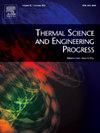表面织构和表面活性剂对铜垂直向下表面池沸腾性能影响的实验研究
IF 5.1
3区 工程技术
Q2 ENERGY & FUELS
引用次数: 0
摘要
沸腾表面的取向依赖性对基于沸腾传热的两相热管理系统的传热性能提出了重大挑战。据报道,当沸腾面向下(180⁰朝向)与向上(0⁰朝向)相比,性能显著降低。本研究通过电火花加工(EDM)对表面进行改性,并通过添加10%临界胶束浓度(CMC)的离子表面活性剂十二烷基三甲基溴化铵(DTAB)对基础工作液去离子水(DI)进行改性,研究了向下表面的池沸腾性能。结果表明,在热流密度为200 kW/m2时,与在DI水中的普通表面相比,传热系数显著提高了50%,壁面温度降低了5.5°C。本研究提出的表面改性和流体改性对池沸腾传热的联合效应,有效地解决了沸腾不稳定性,如在低热流密度下(不利重力条件下)遇到的气泡动力学差和蒸汽气泡悬停在沸腾表面上。本文章由计算机程序翻译,如有差异,请以英文原文为准。
Experimental investigation on effects of surface texturing and surfactant on pool boiling performance of a vertically downward-faced copper surface
The orientation dependence of boiling surfaces poses a significant challenge to the heat transfer performance of two-phase thermal management systems working based on boiling heat transfer. Substantial reductions in performance were reported when the boiling surface is downward faced (at 180⁰ orientation) compared to upward faced (0⁰ orientation). The present study investigated the pool boiling performance of a downward-facing surface, incorporating surface modification via electrical discharge machining (EDM) and modification of the base working fluid, deionised (DI) water, by adding 10 % of the critical micelle concentration (CMC) of Dodecyl Trimethylammonium Bromide (DTAB), an ionic surfactant. The results demonstrated a significant enhancement in heat transfer coefficient in the margin of 50 % and a reduction in wall temperature in the range of 5.5 °C compared to the performance of a plain surface in DI water at a heat flux of 200 kW/m2. The combined effect of surface modification and fluid modification on pool boiling heat transfer presented in this study effectively addresses the boiling instabilities, such as poor bubble dynamics and vapor bubbles hovering on boiling surfaces at lower heat fluxes encountered in downward-facing (adverse gravity conditions) surfaces.
求助全文
通过发布文献求助,成功后即可免费获取论文全文。
去求助
来源期刊

Thermal Science and Engineering Progress
Chemical Engineering-Fluid Flow and Transfer Processes
CiteScore
7.20
自引率
10.40%
发文量
327
审稿时长
41 days
期刊介绍:
Thermal Science and Engineering Progress (TSEP) publishes original, high-quality research articles that span activities ranging from fundamental scientific research and discussion of the more controversial thermodynamic theories, to developments in thermal engineering that are in many instances examples of the way scientists and engineers are addressing the challenges facing a growing population – smart cities and global warming – maximising thermodynamic efficiencies and minimising all heat losses. It is intended that these will be of current relevance and interest to industry, academia and other practitioners. It is evident that many specialised journals in thermal and, to some extent, in fluid disciplines tend to focus on topics that can be classified as fundamental in nature, or are ‘applied’ and near-market. Thermal Science and Engineering Progress will bridge the gap between these two areas, allowing authors to make an easy choice, should they or a journal editor feel that their papers are ‘out of scope’ when considering other journals. The range of topics covered by Thermal Science and Engineering Progress addresses the rapid rate of development being made in thermal transfer processes as they affect traditional fields, and important growth in the topical research areas of aerospace, thermal biological and medical systems, electronics and nano-technologies, renewable energy systems, food production (including agriculture), and the need to minimise man-made thermal impacts on climate change. Review articles on appropriate topics for TSEP are encouraged, although until TSEP is fully established, these will be limited in number. Before submitting such articles, please contact one of the Editors, or a member of the Editorial Advisory Board with an outline of your proposal and your expertise in the area of your review.
 求助内容:
求助内容: 应助结果提醒方式:
应助结果提醒方式:


